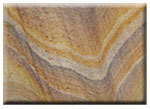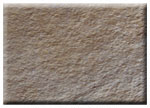

Interesting Stone
Stone is a natural solid formation of one or many minerals. There are thousands of types of stone that have been quarried through the centuries. Quarries are located all around the world. A majority of natural stone comes from Italy, Spain, Turkey, United States, Mexico, China, Taiwan, India, Greece, Canada, France, and Brazil.
The minerals in stone came from the same liquid and gas minerals that formed the earth. The Earth developed as a massive body of gas and liquid minerals that slowly cooled and condensed to a solid core. Through pressure, the  Earth's crust began to form and heavy minerals were forced down to the core of the Earth where they were trapped. As the crust got thicker, it squeezed around the inner core which created intense pressure and heat from within the Earth. Crystals and other solid forms began to grow from the mineral vapors that were being released. As the Earth's crust began to expand and erode, heat and pressure pushed the solid minerals up to the Earth's surface which formed colossal rock beds. It took up to one-hundred million years to form some of these beds. Many of the beds are now used as quarries where the stone is mined.
Earth's crust began to form and heavy minerals were forced down to the core of the Earth where they were trapped. As the crust got thicker, it squeezed around the inner core which created intense pressure and heat from within the Earth. Crystals and other solid forms began to grow from the mineral vapors that were being released. As the Earth's crust began to expand and erode, heat and pressure pushed the solid minerals up to the Earth's surface which formed colossal rock beds. It took up to one-hundred million years to form some of these beds. Many of the beds are now used as quarries where the stone is mined.
Most of these minerals can be identified by their color, hardness, and crystal formation. Crystals come in a variety of shapes and sizes. The wide array of these minerals are often difficult to identify. Many stones look very similar to each other; however, they are all very different. It is imperative to know the exact type of stone that is to be maintained.
A fine grained metamorphic stone that formed from clay, sedimentary rockshale and sometimes quartz.
Slate, being a slip-resistant medium, is often used for different flooring applications. The colors and subtle textures of a slate floor complement most any interior design scheme. Natural slate has a look that cannot be matched using man-made alternatives.
Slate, characterized as unfading, non-absorptive, stain-resistant and unaffected by freeze-thaw cycles or other extreme environmental conditions, serves as the perfect medium for wall cladding applications.
SANDSTONE Sandstone, the sedimentary rock is composed of small grains cemented by silica, with felspathic, or calcareous cementing material. Sandstone is mostly formed in layers and has varied applications as building stones. The formation of sandstone is a result of consolidation of sand and held together by a natural cement, such as silica. The color of the material is largely determined by the cementing material – iron oxides for example produces red or reddish-brown sandstone, and the other materials produce sandstone in the shades white, gray or yellow.
Sandstone, the sedimentary rock is composed of small grains cemented by silica, with felspathic, or calcareous cementing material. Sandstone is mostly formed in layers and has varied applications as building stones. The formation of sandstone is a result of consolidation of sand and held together by a natural cement, such as silica. The color of the material is largely determined by the cementing material – iron oxides for example produces red or reddish-brown sandstone, and the other materials produce sandstone in the shades white, gray or yellow.
Sandstone has been widely used for raising walls since ages. The finely grained, compact, quite hard, stone with good compressive strength and low absorption property, is the perfect medium for walls. The walls of sandstone have been a part of most of monuments. The fireproof, non-slip sandstone, is mostly used for wall cladding not only because of its strength but because of its decorative look.
LIMESTONE Mainly consists of calcite. It does not show much graining or crystalline structure. It has a smooth granular surface. Varies in hardness. Some dense limestones can be polished. Common colors are black, grey, white, yellow or brown.
Mainly consists of calcite. It does not show much graining or crystalline structure. It has a smooth granular surface. Varies in hardness. Some dense limestones can be polished. Common colors are black, grey, white, yellow or brown.





